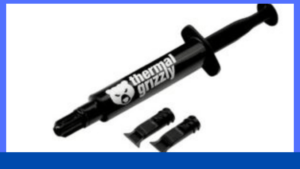Does Thermal Paste Come With CPUs? (And How to use it Correctly) Is it Still Necessary to Apply Thermal Paste to a New CPU If the Cooler Already Has It? The quantity of pre-applied thermal paste will be more than enough for the installation, regardless of whether you choose to buy an AMD CPU, an Intel CPU, or a third-party CPU cooler.
It is not a good idea to combine pastes when adding more thermal paste to the CPU.
However, pre-applied thermal paste has drawbacks of its own. When tightening the cooler down to the CPU, the thermal paste may leak over the socket since it is frequently added uniformly on the cold plate.
The surplus thermal paste will be squeezed out when the cooler is installed, which will also be the case with putting too much thermal paste.
When removing the CPU cooler from the CPU, which is necessary when replacing or upgrading motherboards, for instance, overflowing thermal paste may become a problem.
The heatsink and the CPU are two parts that are prone to sticking and becoming challenging to separate.
Additionally, the quality of thermal pastes can vary greatly, and many overclocking aficionados will, understandably, prefer to apply their variety of thermal paste to the CPU cooler rather than settling for the pre-applied paste.
In either scenario, high-concentration rubbing alcohol must be used to remove the thermal paste, and it should be placed on a microfiber cloth (preferably) or a paper towel.
The fresh thermal paste can then be applied to the CPU rather than the CPU cooler once the old thermal paste has been removed and the cold plate surface of the cooler has dried.
It should be noted that many CPU coolers come with a syringe of a thermal paste rather than having it applied already so that consumers can apply it however they see fit.
The process of building a new PC might be challenging, but it can also be thrilling. In either case, you should avoid rushing the procedure.
There are numerous things to consider, and small mistakes can seriously harm highly expensive hardware components.
Installation of the CPU is one such region that needs special attention, and thermal paste is essential to this installation.
Now, the next post will provide you with a breakdown of all you need to know if you’re unsure of how and when to add it to your device.
We’ll go over safe CPU installation techniques to move you one step closer to finishing your PC’s assembly.
Do CPUs Require Thermal Paste?
Temperatures caused by CPUs, which frequently run hot, can exceed 100 degrees Celsius. As a result, the PC may stutter, freeze, or even shut down. This can cause the processor to throttle. A continuation that is too long may result in catastrophic failure.
A cooler is an element that must be linked to the processor to control the CPU’s temperatures.
These coolers can either use a liquid coolant or a fan’s static pressure to cool a heatsink that dissipates the thermal energy from the CPU (usually ethylene glycol).
The latter collects heat from the processor, travels to a radiator to cool off, and then returns to the CPU to repeat the process.
Regardless of the kind of CPU cooler you choose, the processor will always be connected to it through a cold plate. Copper or aluminum cold plates are designed to absorb heat from the integrated heat spreader in the CPU (IHS).
Due to flaws in the metals that can result in micro-air bubbles being trapped between them, the contact created between these two materials will never be ideal.
To mediate their connection and reduce thermal resistance, a liquid medium is needed. A Thermal Interface Material (TIM) is used here, which is why it is crucial to maintain the CPU’s ideal working temperatures (which should be under 70 to 80 degrees Celsius).
The thermally conductive chemical compound insulates the interface region and maximizes heat transfer by removing any air gaps between the processor and the cold plate.
Are thermal pastes included with AMD CPUs?
Thermal paste will never become bonded to the CPU itself, so keep that in mind. Instead, it might or might not be pre-applied on the CPU cooler’s cold plate.
Thus, unless they are packaged with a stock cooling system, AMD’s processors will not come with thermal paste. AMD’s heatsinks often take the form of an air cooler called a Wraith Stealth, Wraith Spire, or Wraith Prism.
The Ryzen 5 5600X is the only processor for the new generation of Zen 3, Ryzen 5000 Series CPUs, to come with a cooling solution (a Wraith Stealth).
There are a lot more stock-cooled alternatives available for their Zen 2 and Ryzen 3000 series CPUs than their prior generation. Only the Ryzen 9 series and Ryzen 7 XT series CPUs from the Zen 2 generation lack a cooling system.

Are thermal pastes included with Intel CPUs?
Like AMD, Intel’s CPU will not come with thermal paste unless it is packaged with a CPU cooler. Having said that, their basic heatsinks do have a thermal paste that has already been applied.
Unless the CPU is inside a pre-built desktop, a CPU cooler will not be supplied if you buy a CPU unboxed (or OEM). Use of your thermal paste is usually recommended for used CPUs.
Any boxed CPU for an Intel processor that is not an X or K model will have a cooling system. For instance, the cooler will be present on the Intel i7-11700 processor but not on the i7-11700K.
The PCG 2019C cooler that comes with Intel’s 11th generation Rocket Lake CPUs is rated for up to 95 Watts of thermal design power (TDP).
How to Apply Thermal Paste Correctly
You must first secure the CPU in its motherboard socket by connecting it to the socket and applying thermal paste as directed.
The CPU’s heat spreader should then have a pea-sized amount applied to it in the center. The “Penta-dot approach” is a different way to apply paste that involves placing smaller dots close to the CPU’s corners and a fifth dot in the center.
Regarding how much thermal paste should be applied to the CPU, there have been numerous discussions.
Does the way the paste is spread affect how well the CPU conducts heat? The truth is that actual benchmarks (Linus Tech Tips) have shown that the differences between these different approaches are all but insignificant compared to a CPU’s operational temperatures.
Given that a minimum threshold is met, even the quantity of thermal paste applied will have little to no effect (Gamer’s Nexus).
Making sure thermal paste is applied to the heat spreader’s surface after the CPU cooler has been mounted and tightened down is a straightforward but helpful rule of thumb.
This is why a pea-sized quantity is usually adequate. After using the paste, store it correctly to ensure that it will last until your next upgrade.
Final thought
Even though assembling components costing hundreds of dollars can be difficult, it can also be exhilarating and unquestionably gratifying.
There are some essential precautions you should always take when installing a new CPU and its companion cooler.
First, check to see if your preferred CPU cooler has thermal paste, either pre-applied or in a tube. When the time comes to create your new computer, the last thing you want to do is wait for one to appear or go looking for one.
Stock coolers from CPU manufacturers will always have paste already applied. You will need to buy the thermal paste separately if your CPU model does not include a supplemental cooler (boxed or unboxed).
Second, if the paste has already been applied and you are satisfied with it, all you need to do is connect and fasten the cooler to its socket.
If the paste hasn’t already been applied, distribute a pea-sized amount of it in the center of the CPU’s heat spreader before connecting and securing the cooler to its socket.
Related article:
Can We Use Toothpaste Instead Of Thermal Paste On CPU? (Explained)




